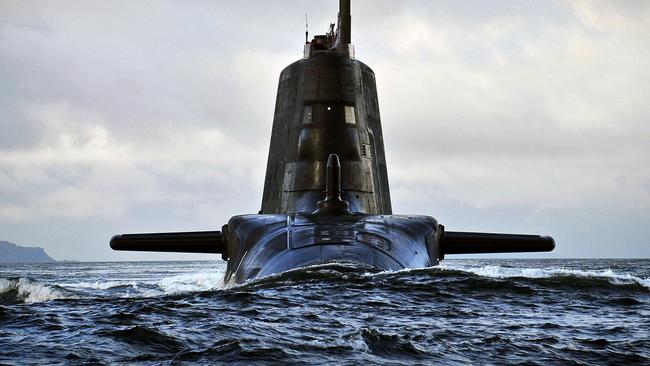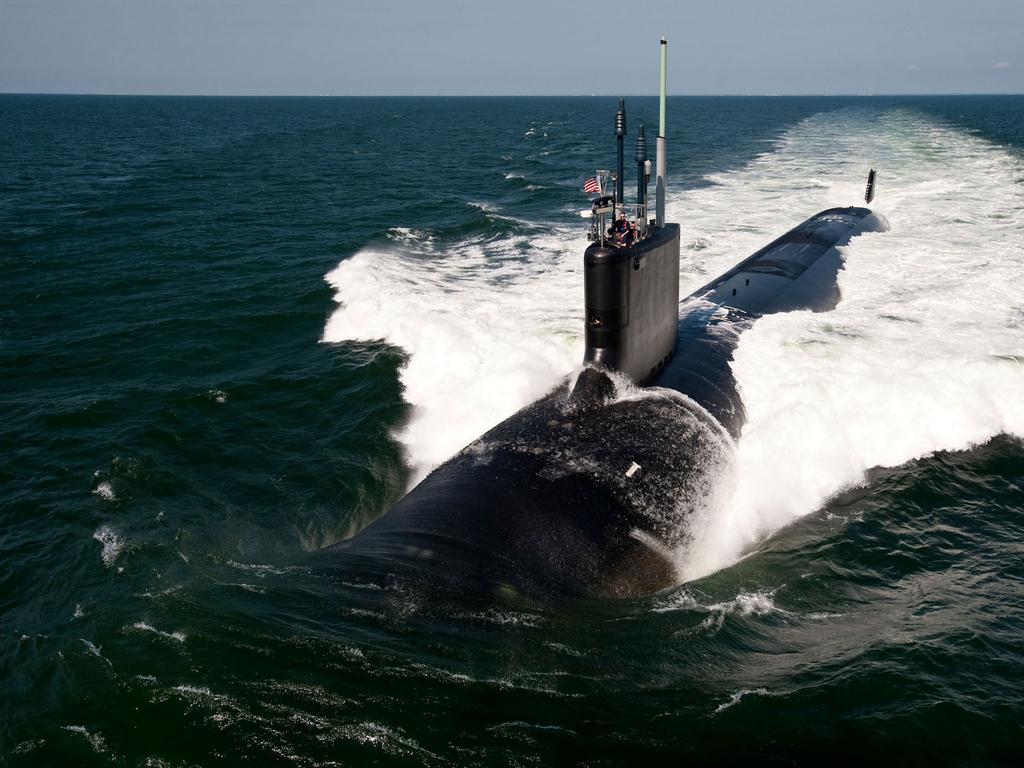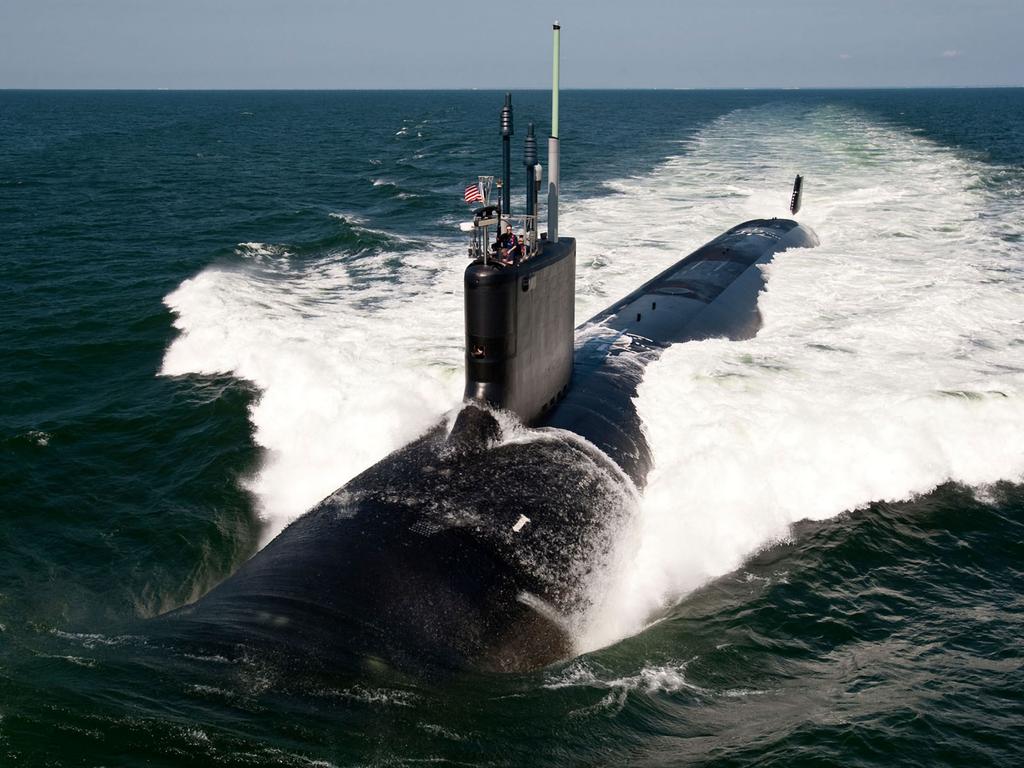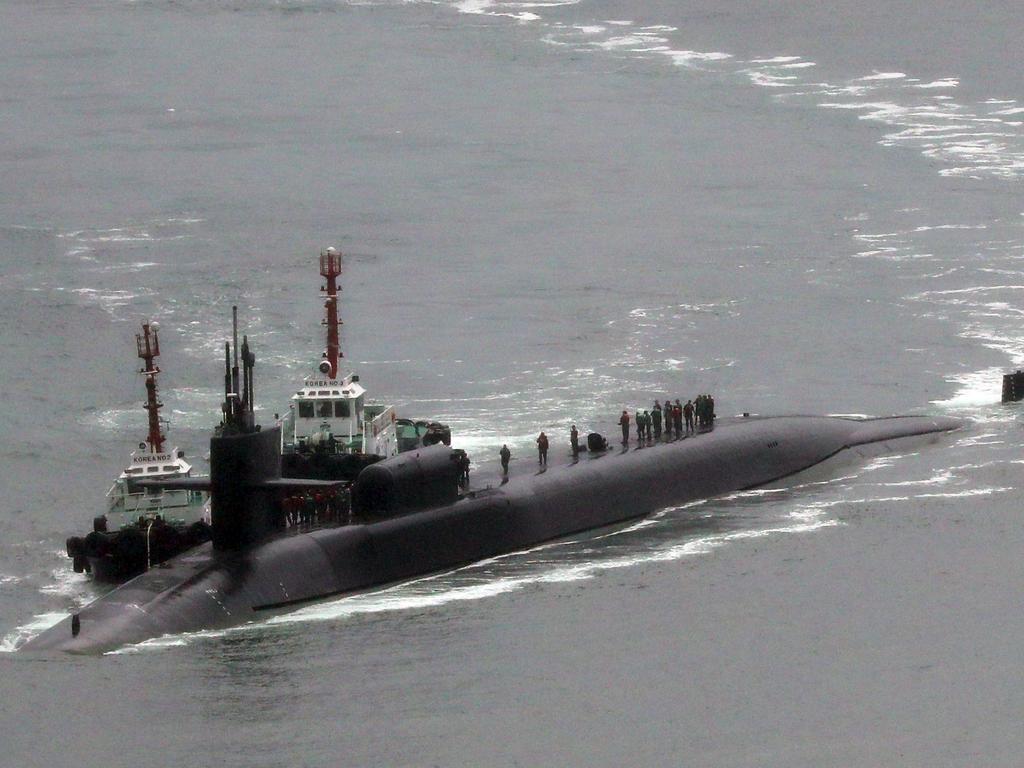AUKUS gives us more problems than solutions and our safety is at stake
The timelines for Australia’s transition from ageing Collins-class to its first nuclear-powered sub just don’t add up. There is hardly a single strategist in the country who believes it will happen.

The Morrison government faces a series of critical multi-billion dollar decisions in the coming year that will set the course of Australia’s maritime defence for the next half a century.
These will require Canberra to test the limits of its alliance with both the US and the UK to ensure they make good on their AUKUS promise to share their sensitive nuclear know-how to help Australia acquire a nuclear-powered submarine fleet.
As the dust finally settles after the initial shock of the AUKUS announcement, several things are becoming clearer. Firstly, the good news is that the AUKUS arrangement has been largely accepted by countries in the Indo-Pacific, with the obvious exception of China which was never going to welcome a strategic partnership that is aligned against it. The Association of South-East Nations has refused to take a public stance against AUKUS despite being urged to do so by Beijing. This was no small thing. Elsewhere in the world, with the obvious exception of France which lost its $90bn submarine contract, the reaction to AUKUS has been largely benign.
But the not-so-good news is that AUKUS has delivered as many conundrums for Australia as it has solutions.
Few strategic experts have questioned the long-term benefits of the game-changing AUKUS promise to help the Royal Australian Navy acquire its first nuclear-powered submarines. With their far superior range, stamina and strike power, they will eventually make Australia a much more formidable foe that it would be with a fleet of conventionally powered submarines.
Add to this the broader AUKUS technology-sharing partnerships with the US and UK – and the strong message of unity that AUKUS sends about the US commitment to the Indo-Pacific – and it is clear that the pact will have long-term benefits for Australia.
But in the short term, the AUKUS announcement and the related scrapping of the French submarine project offers far more problems than solutions.
The timelines for Australia’s transition from its ageing Collins-class submarines to its first nuclear-powered submarine just don’t add up. Put simply, unless something changes, Australia risks having either no submarine fleet or a grossly antiquated one in the late 2030s and early 2040s at a time when China’s maritime power, especially its submarine capabilities, will be peaking.
“There are no easy solutions to this,” says Marcus Hellyer, a senior analyst with the Australian Strategic Policy Institute. “When you are looking at those timelines, the Collins-class boats can’t get there.”
The government has given itself up to 18 months from the AUKUS announcement in September to study its options, although it says it hopes to decide on a plan of action earlier.
But something major has to change or else Australia’s defence will be compromised.
A raft of possible solutions have been floated informally by politicians, defence officials and strategic experts but there has been furious disagreement about what is realistic and possible.
The first contested question is how long the existing six Collins-class submarines can be kept at sea ahead of the arrival of the first nuclear-powered boat.

Defence Minister Peter Dutton said this year that all six Collins boats would undergo a complete two-year refit, known as a life-of-type extension, to keep them in the water for a decade longer than was originally planned.
This will begin on a rolling basis every two years from 2026, meaning that the first of the refitted Collins boats will retire in 2038 and the last in 2048.
The trouble is that the government’s initial projection for the completion of the first of eight nuclear-powered submarines, which it claims will be built in Adelaide, is not until 2038, meaning it would not be brought into naval service for another two years after that, in 2040, with one new nuclear boat every three years after that. This timetable is hugely ambitious and there is hardly a single strategist in the country who believes this will happen. The lessons of naval shipbuilding in Australia is that a first-of-class boat is never completed on time, much less the building of a nuclear submarine – easily the most complex construction of its kind in the country’s history.
So even on this unrealistic timeline, there would be no more than five submarines operating in Australia until 2053, a manifestly inadequate number in an era of a rising China.
The solutions that have been floated, in no particular order, are to shorten the process by building at least some of the nuclear submarines overseas rather than in Australia; lease nuclear submarines from the US or UK; build a new conventional submarine in Australia as an interim measure; or extend the life of the Collins for a second refit cycle, meaning they would be sailing into the 2050s.
Every one of these proposals is problematic.

The most unlikely solution was the one floated by Navy chief Vice Admiral Michael Noonan in Senate Estimates in October when he suggested that the Collins could have a second life-of-type-extension in the 2040s which would keep them sailing until the early 2050s. The Collins boats were commissioned between 1996 and 2003 with an expected lifespan of 30 years, not 50 years.
“Defence’s suggestion in the Senate recently that Collins might require two life extensions is preposterous and can only reflect bad advice,” former navy commodore Paul Greenfield and the head of the think-tank Submarines for Australia, Jon Stanford, wrote in a recent joint paper.
Former rear admiral Peter Briggs tells Inquirer that such a move would be “very problematic”. “We have no idea what is going to go wrong if we try to extend a 40-year-old submarine for another 10 years,” he says.
Such a move would make the Collins older than the 44-year-old Indonesian navy submarine the KRI Nanggala which sank off Bali earlier this year with the loss of all 53 crew.
Even if the Collins boats were somehow kept in the water for longer than 2038, they would almost certainly not be “regionally superior” anymore, and would most likely be unfit for combat.
Briggs is one of a small group of senior ex-navy commanders and former shipbuilders who believes that the only way to ensure a continuous submarine capability is to build another conventional submarine in Australia to bridge the gap between the retirement of the Collins and the arrival of the first nuclear boat.
He says this would relieve pressure on the timeline for the nuclear boats and would help maintain Adelaide’s naval shipbuilding industry and provide a better platform to train the crews needed for the new nuclear fleet.
But the government and the navy do not like this idea and flatly denied a recent news report that defence was discussing the option.
When Dutton was asked about this option recently he swatted it away, hinting that he would instead seek to speed up the process for acquiring nuclear subs.
“I’m not conceding that the submarines will arrive in 2040 … we will make a decision to get those boats into our fleet as quickly as possible,” Dutton said.
Defence believes a new conventional submarine would be too difficult because it would be juggling three different classes of submarines during the transition to the nuclear boats.
“I am sympathetic to Defence’s view that this would mean it is trying to do the biggest submarine project in the history of the country and trying to keep the ageing Collins boats going while also doing a new conventional submarine project,” says ASPI’s Hellyer. “But I also can’t escape the fact that I don’t know how you keep Collins going to flow into a nuclear submarine program with the Collins still being a relevant capability and with the need to train up the uniform workforce you need for the nuclear subs.”

Briggs believes Australia could construct an evolved version of the Collins-class boat with the help of its original Swedish designer Saab Kockums.
“I think you could minimise the disruption by building an updated Collins,” he says. “It is still a big design job but it is a design that we know. We are updating the one we’ve got and that would make it quicker to build and you would not expect to have the same type of problems that we had with the first build of Collins.”
Rear Admiral Greg Sammut, General Manager of Submarines, told a Senate hearing in November that Defence looked at the concept of an evolved Collins design back in 2012 and rejected the idea because it did not offer the advantageous shortcuts that might have been expected.
“The evolved Collins option was studied and examined – in essence the outcome of that study was that the number of changes that would be necessary to the submarines would in fact constitute work equivalent to a new design,” Sammut said. “And trying to tether that design to the existing class would limit the capabilities of the vessel that we were seeking to meet the requirements of.”
So if the government chooses not to build a new conventional submarine and it deems that the Collins can be extended only for a decade, rather than two decades, then the only option is to acquire nuclear submarines more quickly than the current 2040 guideline.
This is the option that Dutton is pursuing but it requires delicate diplomacy with Australia’s AUKUS partners. First, Dutton must decide whether to ditch the government’s intention to build the eight nuclear submarines in Adelaide. While building all boats here will maximise Australian defence industry content, it will almost certainly slow the project down compared to a decision which would allow at least the first few boats to be constructed in US or UK shipyards.
Second, Dutton must choose between acquiring the US Virginia-class or the UK’s Astute-class submarines. Neither the UK nor the US production lines have room to include Australian boats in the foreseeable future. Dutton would need to lean heavily on London or Washington to make room for Australian boats to be constructed in their own shipyards. In the US, it would probably require Australia to partly fund a third shipyard to build the Virginia-class boats because the current two shipyards are struggling to keep up with the orders of the US Navy.
Hellyer believes the choice between the two countries is simple. “With nuclear submarines, we are not just picking a boat we are picking a strategic partner and that can only be the US,” he says.
“If AUKUS is about building alliances in the Indo-Pacific, why would you pick as your strategic partner a country on the other side of the world that is not grappling every day with the challenges of Chinese power.”
Hellyer also points out that the US has a greater shipbuilding capacity than the UK and could build submarines for Australia faster. Another advantage of the Virginia-class boats is that they already have a US combat system, whereas if Australia purchased the Astute boats, the navy would almost certainly seek to modify them to include a US combat system – a change which would add cost, risk and delay to the final Australian submarine.
However, ditching the British submarine option would require delicate diplomacy from Canberra given that Britain’s prime minister Boris Johnson promised that the AUKUS deal would create “hundreds” of highly skilled jobs across the UK and would reinforce Britain’s place “at the leading edge of science and technology”.
Briggs believes that Australia will eventually choose the UK’s Astute-class submarine because he doesn’t believe that the Americans will make its nuclear technology available to Australia despite the promises made in the initial AUKUS announcement.
The Morrison government appears to have gone cold on the option of leasing nuclear submarines to get them into the navy earlier. On closer inspection, neither the UK or the US have submarines available to lease. And in any case, Australia does not have the crews or the skills to sail them.
It will take at least a decade and probably longer for Australia to be able to train enough crew to the high levels required to man a nuclear-powered boat. A vast amount of that training will need to be done in the US or UK while Australia builds up the nuclear infrastructure and knowledge that will be needed to crew, maintain and manage a nuclear fleet.
All of these options amount to multi-billion dollar decisions by the government. If the wrong option is chosen, it will not only hit taxpayers, but it could severely compromise the country’s defence for decades.
The stakes could not be higher as the government moves to turn AUKUS from rhetoric to reality.






Now that Australia has finally weathered the diplomatic fallout caused by the creation of the three-nation AUKUS pact, it is time to work out exactly what it means for the nation’s security.